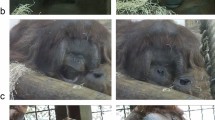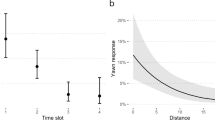Abstract
Among some haplorhine primates, including humans, relaxed yawns spread contagiously. Such contagious yawning has been linked to social bonds and empathy in some species. However, no studies have investigated contagious yawning in strepsirhines. We conducted an experimental study of contagious yawning in strepsirhines, testing ring-tailed and ruffed lemurs (n = 24) in a paradigm similar to one that has induced contagious yawning in haplorhines. First, in a control experiment, we investigated whether lemurs responded to projected video content in general (experiment 1). We showed them two videos to which we expected differential responses: one featured a terrestrial predator and the other a caretaker holding food. Next, to test for yawn contagion, we showed individual lemurs life-size video projections of groupmates and conspecific strangers yawning, and control footage of the same individuals at rest (experiment 2). Then, to examine whether a group context might enhance or allow for contagion, we exposed subjects to the same videos in a group setting (experiment 3). Lemurs produced alarm vocalizations and moved upward while viewing the predator, but not the caretaker, demonstrating that they do perceive video content meaningfully. However, lemurs did not yawn in response to yawning stimuli when tested alone, or with their groupmates. This study provides preliminary evidence that lemurs do not respond to yawning stimuli similarly to haplorhines, and suggests that this behavior may have evolved or become more exaggerated in haplorhines after the two major primate lineages split.




Similar content being viewed by others
References
Altmann SA (1967) Social communication among Primates. University of Chicago Press, Chicago, 325–362
Amici F, Aureli F, Call J (2014) Response facilitation in the four great apes: is there a role for empathy? Primates 55:113–118. doi:10.1007/s10329-013-0375-1
Anderson JR, Myowa-Yamakoshi M, Matsuzawa T (2004) Contagious yawning in chimpanzees. Proc R Soc Lond B Biol Sci 271:S468–S470
Aureli F, van Schaik CP (1991) Post-conflict behaviour in long tailed macaques (Macaca fascicularis): II. coping with the uncertainty. Ethology 89:101–114
Baenninger R (1997) On yawning and its functions. Psychon Bull Rev 4:198–207
Baker KC, Aureli F (1997) Behavioural indicators of anxiety: an empirical test in chimpanzees. Behaviour 134:1031–1050
Bray J, Krupenye C, Hare B (2014) Ring-tailed lemurs (Lemur catta) exploit information about what others can see but not what they can hear. Anim Cogn 17:735–744
Campbell MW, De Waal FB (2011) Ingroup-outgroup bias in contagious yawning by chimpanzees supports link to empathy. PLoS ONE 6:e18283
Campbell MW, de Waal FB (2014) Chimpanzees empathize with group mates and humans, but not with baboons or unfamiliar chimpanzees. Proc Biol Sci 281:20140013. doi:10.1098/rspb.2014.0013
Castles DL, Whiten A (1998) Post-conflict behaviour of wild olive baboons: stress and self-directed behaviour. Ethology 104:148–160
Cools AK, Van Hout AJM, Nelissen MH (2008) Canine reconciliation and third-party-initiated postconflict affiliation: do peacemaking social mechanisms in dogs rival those of higher primates? Ethology 114:53–63
Cordoni G, Palagi E (2008) Reconciliation in wolves (Canis lupus): new evidence for a comparative perspective. Ethology 114(3):298–308
Cozzi A, Sighieri C, Gazzano A, Nicol CJ, Baragli P (2010) Post-conflict friendly reunion in a permanent group of horses (Equus caballus). Behav Process 85:185–190
de Waal FB (2008) Putting the altruism back into altruism: the evolution of empathy. Annu Rev Psychol 59:279–300. doi:10.1146/annurev.psych.59.103006.093625
De Waal FBM, van Roosmalen A (1979) Reconciliation and consolation among chimpanzees. Behav Ecol Sociobiol 5:55–66
Demuru E, Palagi E (2012) In bonobos yawn contagion is higher among kin and friends. PLoS ONE 7:e49613. doi:10.1371/journal.pone.0049613
Drea CM, Scordato ES (2008) Olfactory communication in the ringtailed lemur (Lemur catta): form and function of multimodal signals. In: Beynon RJ, Craig Roberts S, Wyatt TD (eds) Chemical signals in vertebrates, vol 11. Springer, Berlin, pp 91–102
Fichtel C, Kappeler PM (2010) Human universals and primate symplesiomorphies: establishing the lemur baseline. In: Kappeler PM, Silk JB (eds) Mind the gap. Springer, Berlin, pp 395–426
Gallup AC (2011) Why do we yawn? Primitive versus derived features. Neurosci Biobehav Rev 35:765–769
Harcourt AH, De Waal FB (1992) Coalitions and alliances in humans and other animals. Oxford University Press, Oxford
Harr AL, Gilbert VR, Phillips KA (2009a) Do dogs (Canis familiaris) show contagious yawning? Anim Cogn 12:833–837. doi:10.1007/s10071-009-0233-0
Harr AL, Gilbert VR, Phillips KA (2009b) Do dogs (Canis familiaris) show contagious yawning? Anim cogn 12:833–837
Hofer H, East ML (2000) Conflict management in female-dominated spotted hyenas. In: Aureli F, de Waal F (eds) Natural conflict resolution. University of California Press, Berkeley, pp 232–234
Joly-Mascheroni RM, Senju A, Shepherd AJ (2008) Dogs catch human yawns. Biol Lett 4:446–448
Kappeler PM (1993) Reconciliation and post-conflict behaviour in ringtailed lemurs, Lemur catta and redfronted lemurs, Eulemur fulvus rufus. Anim Behav 45:901–915
Kendal RL, Custance DM, Kendal JR, Vale G, Stoinski TS, Rakotomalala NL, Rasamimanana H (2010) Evidence for social learning in wild lemurs (Lemur catta). Learn Behav 38:220–234
Kutsukake N, Clutton-Brock TH (2008) Do meerkats engage in conflict management following aggression? Reconciliation, submission and avoidance. Anim Behav 75:1441–1453
Leone A, Ferrari PF, Palagi E (2014) Different yawns, different functions? Testing social hypotheses on spontaneous yawning in Theropithecus gelada. Sci Rep 4
Lund JD, Jørgensen MC (1999) Behaviour patterns and time course of activity in dogs with separation problems. Appl Anim Behav Sci 63:219–236
Macedonia JM, Taylor LL (1985) Subspecific divergence in a loud call of the ruffed lemur (Varecia variegata). Am J Primatol 9:295–304
MacLean EL, Merritt DJ, Brannon EM (2008) Social complexity predicts transitive reasoning in prosimian primates. Anim Behav 76:479–486
MacLean EL et al (2012a) How does cognition evolve? Phylogenetic comparative psychology. Anim Cogn 15:223–238
MacLean EL, Mandalaywala TM, Brannon EM (2012b) Variance-sensitive choice in lemurs: constancy trumps quantity. Anim Cogn 15:15–25
MacLean EL et al (2014) The evolution of self-control. Proc Natl Acad Sci 111:E2140–E2148
Marechal L, Genty E, Roeder JJ (2010) Recognition of faces of known individuals in two lemur species (Eulemur fulvus and E. macaco). Anim Behav 79:1157–1163
Merritt D, Maclean EL, Jaffe S, Brannon EM (2007) A comparative analysis of serial ordering in ring-tailed lemurs (Lemur catta). J Comp Psychol 121:363–371. doi:10.1037/0735-7036.121.4.363
Merritt DJ, Maclean EL, Crawford JC, Brannon EM (2011) Numerical rule-learning in ring-tailed lemurs (Lemur catta). Front Psychol 2:23. doi:10.3389/fpsyg.2011.00023
Miller ML, Gallup AC, Vogel AR, Vicario SM, Clark AB (2012) Evidence for contagious behaviors in budgerigars (Melopsittacus undulatus): an observational study of yawning and stretching. Behav Process 89:264–270. doi:10.1016/j.beproc.2011.12.012
Moyaho A, Rivas-Zamudio X, Ugarte A, Eguibar JR, Valencia J (2015) Smell facilitates auditory contagious yawning in stranger rats. Anim Cogn 18:279–290
Nakamichi M, Koyama N (1997) Social relationships among ring-tailed lemurs (Lemur catta) in two free-ranging troops at Berenty Reserve, Madagascar. Int J Primatol 18(1):73–93
Norscia I, Palagi E (2011) Yawn contagion and empathy in Homo sapiens. PLoS ONE 6:e28472. doi:10.1371/journal.pone.0028472
Nunn CL, Deaner RO (2004) Patterns of participation and free riding in territorial conflicts among ringtailed lemurs (Lemur catta). Behav Ecol Sociobiol 57:50–61. doi:10.1007/s00265-004-0830-5
O’Hara SJ, Reeve AV (2011) A test of the yawning contagion and emotional connectedness hypothesis in dogs, Canis familiaris. Anim Behav 81:335–340
Palagi E, Paoli T, Tarli SB (2005) Aggression and reconciliation in two captive groups of Lemur catta. Int J Primatol 26:279–294
Palagi E, Antonacci D, Norscia I (2008) Peacemaking on treetops: first evidence of reconciliation from a wild prosimian (Propithecus verreauxi). Anim Behav 76:737–747
Palagi E, Leone A, Mancini G, Ferrari P (2009) Contagious yawning in gelada baboons as a possible expression of empathy. Proc Natl Acad Sci 106:19262–19267
Palagi E, Norscia I, Demuru E (2014) Yawn contagion in humans and bonobos: emotional affinity matters more than species. PeerJ 2:e519. doi:10.7717/peerj.519
Paukner A, Anderson JR (2006) Video-induced yawning in stumptail macaques (Macaca arctoides). Biol Lett 2:36–38. doi:10.1098/rsbl.2005.0411
Pereira ME, Kappeler PM (1997) Divergent systems of agonistic behaviour in lemurid primates. Behaviour 134:225–274
Peterson RO, Ciucci P (2003) The wolf as a carnivore. In: Wolves: behavior, ecology, and conservation. University of Chicago Press, Chicago, pp 104–130
Platek SM, Critton SR, Myers TE, Gallup GG (2003) Contagious yawning: the role of self-awareness and mental state attribution. Cogn Brain Res 17:223–227. doi:10.1016/s0926-6410(03)00109-5
Pongrácz P, Miklósi Á, Dóka A, Csányi V (2003) Successful application of video-projected human images for signalling to dogs. Ethology 109:809–821
Provine RR (1986) Yawning as a stereotyped action pattern and releasing stimulus. Ethology 72:109–122
Rice WR, Gaines SD (1994) Heads I win, tails you lose’: testing directional alternative hypotheses in ecological and evolutionary research. Trends Ecol Evol 9:235–236
Rolland N, Roeder JJ (2000) Do ringtailed lemurs (Lemur catta) reconcile in the hour post-conflict?: a pilot study. Primates 41:223–227
Romero T, Konno A, Hasegawa T (2013) Familiarity bias and physiological responses in contagious yawning by dogs support link to empathy. PLoS ONE 8:e71365. doi:10.1371/journal.pone.0071365
Romero T, Ito M, Saito A, Hasegawa T (2014) Social modulation of contagious yawning in wolves. PLoS One 9(8):e105963
Sandel AA, MacLean EL, Hare B (2011) Evidence from four lemur species that ringtailed lemur social cognition converges with that of haplorhine primates. Anim Behav 81:925–931
Sauther ML (1989) Antipredator behavior in troops of free-ranging Lemur catta at Beza Mahafaly Special Reserve, Madagascar. Int J Primatol 10:595–606
Sauther ML, Sussman RW, Gould L (1999) The socioecology of the ringtailed lemur: thirty-five years of research. Evolut Anthropol Issues News Rev 8:120–132
Schino G (1998) Reconciliation in domestic goats. Behaviour 135(3):343–356
Seed AM, Clayton NS, Emery NJ (2007) Postconflict third-party affiliation in rooks, Corvus frugilegus. Curr Biol 17:152–158
Senju A, Maeda M, Kikuchi Y, Hasegawa T, Tojo Y, Osanai H (2007) Absence of contagious yawning in children with autism spectrum disorder. Biol Lett 3:706–708. doi:10.1098/rsbl.2007.0337
Seyfarth RM, Cheney DL (2013) Affiliation, empathy, and the origins of theory of mind. Proc Natl Acad Sci 110:10349–10356
Silva K, Bessa J, de Sousa L (2012) Auditory contagious yawning in domestic dogs (Canis familiaris): first evidence for social modulation. Anim Cogn 15:721–724
Smith E (1999) Yawning: an evolutionary perspective. Hum Evol 14:191–198
Stoinski T, Drayton L, Price E (2011) Evidence of social learning in black-and-white ruffed lemurs (Varecia variegata). Biol Lett 7:376–379
Tamaki N, Morisaka T, Taki M (2006) Does body contact contribute towards repairing relationships?: The association between flipper-rubbing and aggressive behavior in captive bottlenose dolphins. Behav Process 73:209–215
Vasey N (2007) Impact of seasonality and reproduction on social structure, ranging patterns, and fission–fusion social organization in red ruffed lemurs. In: Gould L, Sauther ML (eds) Lemurs: ecology and adaptation. Springer, Berlin, pp 275–304
Wyndham E (1980) Diurnal cycle, behaviour and social organization of the Budgerigar Melopsittacus ndulatus. Emu 80:25–33
Zannella A, Norscia I, Stanyon R, Palagi E (2015) Testing yawning hypotheses in wild populations of two strepsirrhine species: Propithecus verreauxi and Lemur catta. Am J Primatol 77:1207–1215. doi:10.1002/ajp.22459
Acknowledgments
This project would not have been possible without the help of the staff at the Duke Lemur Center, especially Dr. Erin Ehmke, David Brewer, Julie McKinney, and Meg Dye. We would also like to thank Joel Bray, Ben Finkel, Leah Kaiser, Laura Lewis, Jeremy Clift, Sruti Pisharody, and Seraphina Wong for their help with stimuli and data collection and coding. We would also like to thank Dr. Anne Pusey and Dr. Tanya Chartrand for their helpful feedback in earlier stages of this project, Aaron Sandel for his comments on the manuscript, and two anonymous reviewers for their feedback. This research was supported by a Grant from the Undergraduate Research Support office at Duke University and a Molly H. Glander Student Research Grant from the Duke Lemur Center. RBR and CK were supported by NSF GRFP DGE-1256260 and DGE-1106401, respectively.
Author information
Authors and Affiliations
Corresponding author
Ethics declarations
Ethical approval
All applicable international, national, and/or institutional guidelines for the care and use of animals were followed. All procedures performed in studies involving animals were in accordance with the ethical standards of the Institutional Animal Care and Use Committee at Duke University (Protocol # A199-11-08).
Rights and permissions
About this article
Cite this article
Reddy, R.B., Krupenye, C., MacLean, E.L. et al. No evidence for contagious yawning in lemurs. Anim Cogn 19, 889–898 (2016). https://doi.org/10.1007/s10071-016-0986-1
Received:
Revised:
Accepted:
Published:
Issue Date:
DOI: https://doi.org/10.1007/s10071-016-0986-1




